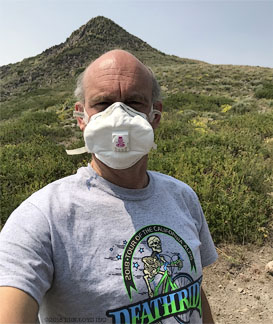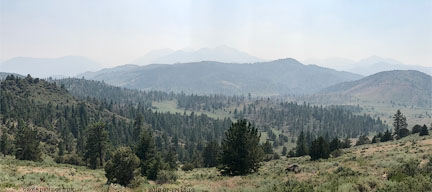The Ferguson Fire near Yosemite Valley: Save your Lungs and Your Health if Traveling in California, But Applies to Much More than Smoke
See P100 / N100 Particulate Respirator Works for Smoke for more details on protecting your short and long term health—Bad Stuff into lungs can cause diabetes, cancer, heart disease and more—take it very, very seriously. See reader comments at end. Some stuff NEVER comes out or heals.
The Ferguson Fire is making a huge mess of the Yosemite area and polluting a wide swath around that area. No way will I be going to the mountains until it burns itself out.
Below—since I could not smell the smoke and it seemed to be below me, I thought my lungs would be OK. Well, 10 days after driving back through mild smoke, my lungs are still impaired, with the inhaler barely keeping lung impairment under control. It is dangerous stuff.

I thought it irresponsible for the media (every outlet I have seen so far) to say nothing of simple precautions that ought to be taken—tourists including children visiting Yosemite and inhaling nasty stuff sure to cause days if not weeks of trouble for anyone with even minor sensitivity, even potentially lifelong complications for those at serious risk of an immune system trigger.
Everyone should have on-hand a mask like the N100 particular respirator (costs about $9) in the car when visiting the American West—for smoke in particular, but also desert dust and sand (some toxic), pine pollen, etc. I suppose that applies to many cities as well because it is not just smoke*.
- 3M 8233 Particulate Respirator N100 @AMAZON
- 3M Particulate Respirator 8233, N100-4 Count @AMAZON
- 3M Particulate Respirator P100 @AMAZON
Don’t even think about using a toy face mask like the one the tourists are seen wearing on this page. Better than nothing, but not by much.
In my experience (direct interaction), most people who do not formally have asthma do not understand the symptoms, and therefore dismiss a minor cough or a strange feeling in the lungs as temporary, when it can be a red flag that over time (or even quite quickly) lead to permanent loss of lung function. Particularly if the lungs are weakened/irritated and a virus sets up shop for a week or two. I would guess that the majority of people reading this post have experienced at least temporary symptoms and have not connected the dots nor made the mental commitment to wearing a weird-looking face mask when conditions warrant it (“interesting post, but it does not apply to me, I’m fine”).
* There is a tremendous amount of Nasty Stuff in the air near freeways. For example, I remember riders with outrageously filthy faces after Joshua Tree Double this year—I had worn a mask along I25, they had not—just think of all that dirt and grime inhaled into their lungs, lungs being used to most of capacity.
Below, I thought that being in the van with the A/C on and no direct outside air would spare my lungs. The next 50 miles proved me wrong, even though I smelled no smoke: 10 days later I am still experiencing lung impairment in spite of aggressive treatment. Big mistake that I won’t repeat again—I should have worn my face mask. Thing is, this level of smoke is very low compared to some conditions.

iPhone 7 Plus + iPhone 7 Plus 6.6 mm f/2.8 @ 6.6mm
[low-res image for bot]
David M writes:
Thanks for your post about the N100 face mask. A few weeks ago I was photographing on the island of Hawaii and was overwhelmed by the vog (volcanic emissions) from Kīlauea volcano. I've been coughing constantly for the last 3 weeks. My doctor gave me an inhaler, but once you get junk in your lungs, it's there to stay.
I'm going back in 2 weeks and I'll definitely be bringing one of these face masks.
DIGLLOYD: not only can the 'junk' stay, micro scarring can occur, and that can lead to a permanent reduction of lung function (small airways), and a predisposition to viral infections.
I question the wisdom of going back given the damage already done (it can take years for the lungs to recover from some insults, personal experience), but the mask should keep particulate matter out, provided it is properly fitted. Also, the N100 face mask does nothing to keep out chemical vapors like hydrogen sulfide. Were I going back, I’d get something 'serious' with activated carbon.
David C writes:
Lung insults: from some there is no recovery, e.g. silicosis https://en.wikipedia.org/wiki/Silicosis.
I wasn’t aware that even blowing desert sand can cause the disease.
DIGLLOYD: I wasn’t aware of that either. I know that I have a few nodules in my lungs already (from a CT scan after my concussion).
I’ll be wearing a mask for Southern Inyo Double Century and Joshua Tree Double Century from now on, at least in the worst areas, regardless of apparent conditions as there is always some level of dust/fine sand.
Gary writes:
Thanks for your excellent blog today about effects of the Ferguson fires and other sources of pollution.
My 84-year-old wife was a teenager in central London during the pea soup fogs of the 1940s and 1950s. A lifelong non-smoker she has interstitial lung disease and uses an oxygen concentrator frequently. Her disease makes her especially vulnerable to respiratory infections.
What mask might help protect from those infections? Her Kaiser doctors keeping hyping flu vaccine and other vaccines. They don't want to discuss masks. Her doctors seem not to recognize urban air pollution as a problem.
I almost died from pneumonia two years ago from a lung infection after visiting a museum crowded with over 1,000 elementary students. (so many that the floors were carpeted with them eating their lunches) We avoid indoor public places and favor outdoor venues for exercise. We have largely avoided infections in the last two years but would like added protection.
DIGLLOYD: Gary is correct that vaccines are not the answer—they can help, but a less than robust immune system means marginal response to vaccines, rendering them in some cases useless (no meaningful efficacy). There is no way to know short of testing for antibodies post-vaccine, and this is never done AFAIK. Since even lack of sleep reduces the necessary immune system response to vaccines and those with already compromised immune systems might well also have sleep issues, protection via vaccines is a dubious proposition (it would be foolish to skip the vaccine but equally foolish to assume strong efficacy).
In other words, there is a good chance that for those with weak immune systems (e.g. many elderly people), vaccines are a hopeful exercise and cannot be assumed to be reliable way to fend off infections. The CDC shows flu vaccine efficacy as low as 36% in recent years. Plus viruses can mutate and there are many infectious agents besides just influenza.
Viruses are tiny and thus a challenge to filter out (which is why I use a true water purifier in the field, versus a filter). That said, as I understand it the main risk is aerosolized micro droplets of water carrying infectious agents, e.g., from someone coughing or sneezing. Ideally that person wears the mask! Which of course is meaningless, since transmission often occurs even before someone knows they are infected, and few people go to the trouble of wearing a mask while ill (for the sake of others). Seems to me that schools and businesses should mandate their use if a sick person is to be at school/work.
On the aerosolized micro droplets assumption, I expect that the N100 or P100 face masks are highly likely to afford protection. Quantitative studies with an N95 mask show good efficacy if the mask is worn by the infected person (it does not speak to blocking viruses already in the air). An N95 mask is inferior to an N100 or P100 mask, as I understand it.
On the basis of these preliminary findings, both surgical and N95 masks appear equally effective in preventing influenza dissemination from patients with confirmed influenza.
The CDC states that N95 (and thus N100) and P100 face masks are effective against airborne viral agents:
These NIOSH-approved FFRs and particulate respirators equipped with these cartridges can be anticipated to achieve expected levels of protection (consistent with their assigned protection factor) against airborne viral agents, provided that they are properly selected, fitted, worn, and maintained.
Bottom line as I read it: an N100 or P100 face mask appears to be a very good idea for not just airborne contaminants, but effective against infectious agents. Plus merely removing airborne contaminants in and of itself reduces the risk of infection, by preventing lung tissue from being made susceptible to infection by being irritated.
I would go with the P100 face mask @AMAZON, which improves upon the N100 by being rated for blockage of tiny oil-based particles. Anything better is likely to involve a more "serious" mask with activated charcoal and so on—awkward and troublesome and probably not so comfortable.
Finally and IMO, doctors not recognizing air pollution as having serious major health implications affecting numerous systems in the body are clueless in the face of many recent medical studies, and need their competence examined.
- 3M Particulate Respirator P100 @AMAZON
- 3M 8233 Particulate Respirator N100 @AMAZON
- 3M Particulate Respirator 8233, N100-4 Count @AMAZON

Scott H writes:
I didn’t see your comments on the Ferguson Fire until we got back from our trip…we were slated to camp at Saddlebag and photograph around Mono lake the same week you were down there but the smoke/smoke forecasts made us change our mind so we headed North of Tahoe. It was still hazy even North of Tahoe. We escaped it for a day but it came back the second day we were there. Tahoe was quite hazy too. Had we headed down that way I would’ve kept my eyes peeled for your van! I knew smoke was bad but your post enlightened me to even more of the dangers I didn’t know about. I will definitely keep some masks in the camping gear and car from now on! Anyway, just wanted to send a thank you note for all the material you’ve been posting lately, and I’m glad you’re on the mend and feeling better.
DIGLLOYD: good idea to just stay away. My lungs are still impaired 2 weeks after my last trip, and that was light smoke. But maybe it is some local allergen I can’t detect—hard to be sure, but sensitive lungs can take weeks to settle down.
On the mend... maybe—it has been a difficult 10 days feeling like I’m concussed all over again.



























